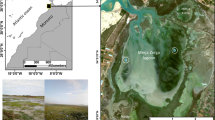Abstract
As one of the major blue carbon ecosystems, studying, conserving, and monitoring seagrass meadows, especially on small populated islands, has become very important due to their vulnerability to anthropogenic and global environmental factors. In this study, we used satellite image analysis and biological data to map seagrass percent cover (SPC), above-ground biomass (AGB), and below-ground biomass (BGB) on the three most populated islands of the Spermonde Archipelago, Indonesia, i.e., Kodingareng Lompo, Barrang Lompo, and Barrang Caddi. Reflectance and Normalized Difference Vegetation Index (NDVI) values of Sentinel-2 (S2) imagery were used to classify and calculate SPC and AGB. In situ biological data measurements were carried out from 3 to 14 of June, 2020, on the three islands to measure AGB and BGB. The result from image classification shows a total area of 126.37 Ha of seagrass, which was divided into three SPC categories: medium (30–59.9%) with a total area of 78.38 Ha; low (0–29.9%) with a total area of 13.1 Ha; and high (60–100%) with a total area of 34.89 Ha. The highest SPC area was observed on Kodingareng Lompo Island with 61.07Ha, followed by Barrang Lompo Island with 53.18Ha, and Barrangcaddi Island with 12.12Ha. The total AGB on Barrang Lompo, Kodingareng Lompo, and Barrangcaddi in tons of dry weight/ha were 1.83, 1.05, and 2.38, respectively. The highest BGB was reported on Barrangcaddi Island with 8.61 tons of dry weight/ha, followed by Barrang Lompo Island with 6.78 tons of dry weight/ha, and Kodingareng Lompo Island with 2.78 tons of dry weight/ha. Regression analysis showed a linear correlation between NDVI value and in situ SPC with R2 = 0.8255. The framework of this study can be applied to monitor temporal changes of seagrass meadows distribution on small islands to promote a more sustainable ecosystem.











Similar content being viewed by others
References
Cabaço S, Apostolaki ET, García-Marín P, Gruber R, Hernández I, Martínez-Crego B, Mascaró O, Pérez M, Prathep A, Robinson C, Romero J, Schmidt AL, Short FT, Van Tussenbroek BI, Santos R (2013) Effects of nutrient enrichment on seagrass population dynamics: evidence and synthesis from the biomass-density relationships. J Ecol 101:1552–1562. https://doi.org/10.1111/1365-2745.12134
Chavez PS Jr (1988) An improved dark-object subtraction technique for atmospheric scattering correction of multispectral data. Remote Sens Environ 24(3):459–479. https://doi.org/10.1016/0034-4257(88)90019-3
Congalton R, Green K (2008) Assessing the accuracy of remotely sensed data, principles and practices, 2nd edn. CRC Press, Boca Raton, p 200
Duarte CM, Marbà N, Gacia E, Fourqurean JW, Beggins J, Barrón C, Apostolaki ET (2010) Seagrass community metabolism: assessing the carbon sink capacity of seagrass meadows. Glob Biogeochem CyCles 24(4):GB4032. https://doi.org/10.1029/2010GB003793
Hedley JD, Harborne AR, Mumby PJ (2005) Simple and robust removal of sun glint for map** shallow-water benthos. Int J Remote Sens 26(10):2107–2112. https://doi.org/10.1080/01431160500034086
Hochberg EJ, Atkinson MJ (2003) Spectral reflectance of coral reef bottom-types worldwide and implications for coral reef remote sensing. Remote Sens Environ 85(2):159–173. https://doi.org/10.1016/S0034-4257(02)00201-8
Kennedy H, Beggins J, Duarte CM, Fourqurean JW, Holmer M, Marbà N, Middelburg JJ (2010) Seagrass sediments as a global carbon sink: Isotopic constraints. Glob Biogeochem Cycles 24(4):GB4026. https://doi.org/10.1029/2010GB003848
Krause-Jensen D, Duarte C (2016) Substantial role of macroalgae in marine carbon sequestration. Nat Geosci 9:737–742. https://doi.org/10.1038/ngeo2790
Lavery PS, Mateo MÁ, Serrano O, Rozaimi M (2013) Variability in the carbon storage of seagrass habitats and its implications for global estimates of blue carbon ecosystem service. PLoS ONE 8(9):e73748. https://doi.org/10.1371/journal.pone.0073748
Lyimo LD (2016) Carbon sequestration processes in tropical seagrass beds. Ph.D. Thesis, Stockholm University, p 49
Lyzenga D (1981) Remote sensing of bottom reflectance and water attenuation parameters in shallow water using aircraft and Landsat data. Int J Remote Sens 2(1):71–82. https://doi.org/10.1080/01431168108948342
Mallombassi A, Mashoreng S, La Nafie YA (2020) The relationship between seagrass Thalassia hemprichii percentage cover and their biomass. Spermonde 6(1):7–10. https://doi.org/10.20956/jiks.v6i1.9922
McKenzie LJ, Finkbeiner MA, Kirkman H (2001) Methods for map** seagrass distribution. In: Short FT, Coles RG (eds) Global seagrass research methods. Elsevier Science, pp 101–121. https://doi.org/10.1016/B978-044450891-1/50006-2
Pu R, Bell S, English D (2015) Develo** hyperspectral vegetation indices for identifying seagrass species and cover classes. J Coast Res 31(3):595–615. https://doi.org/10.2112/JCOASTRES-D-12-00272.1
Roca G, Alcoverro T, Krause-Jensen D, Balsby TJS, van Katwijk MM, Marba N, Santos R, Arthur R, Mascaró O, Fernández-Torquemada Y, Pérez M (2016) Response of seagrass indicators to shifts in environmental stressors: a global review and management synthesis. Ecol Indic 63:310–323. https://doi.org/10.1016/j.ecolind.2015.12.007
Rohr ME, Bostrom C, Canal-Vergés P, Holmer M (2018) Blue carbon storage capacity of temperate Eeelgrass (Zostera marina) meadows. Glob Biogeochem Cy 32:1457–1475. https://doi.org/10.1029/2018GB005941
Waycott M, McMahon K, Mellors J, Calladine A, Kleine D (2004) A guide to tropical seagrass of the Indo-West Pacific. James Cook University, Townsville
Waycott M, Duarte CM, Carruthers TJB, Orth RJ, Dennison WC, Olyarnik S, Calladine A, Fourqurean JW, Heck KL, Hughes AR, Kendrick GA, Kenworthy WJ, Short FT, William SL (2009) Accelerating loss of seagrasses across the globe threatens coastal ecosystems. Proc Natl Acad Sci USA 106(30):12377–12381. https://doi.org/10.1073/pnas.0905620106
Zoffoli ML, Gernez P, Rosa P, Le Bris A, Brando VE, Barillé AL, Harin N, Peters S, Poser K, Spaias L, Peralta G (2020) Sentinel-2 remote sensing of Zostera noltei-dominated intertidal seagrass meadows. Remote Sens Environ 251:112020. https://doi.org/10.1016/j.rse.2020.112020
Acknowledgements
The Ministry of Research Technology and Higher Education of the Republic of Indonesia and Institute for Research and Community Services, Hasanuddin University grant 2021–2022 for their support in providing research funds. Thank you to the Ocean Remote Sensing Project of the Sub-commission of the Western Pacific Intergovernmental Oceanographic Commission/ UNESCO supported by Japan Fund in Trust provided by the Ministry of Education, Culture, Sports, Science and Technology, Japan.
Author information
Authors and Affiliations
Corresponding author
Additional information
Publisher's Note
Springer Nature remains neutral with regard to jurisdictional claims in published maps and institutional affiliations.
Rights and permissions
About this article
Cite this article
Nurdin, N., Amri, K., Mashoreng, S. et al. Estimation of Seagrass Biomass by In Situ Measurement and Remote Sensing Technology on Small Islands, Indonesia. Ocean Sci. J. 57, 118–129 (2022). https://doi.org/10.1007/s12601-022-00054-2
Received:
Revised:
Accepted:
Published:
Issue Date:
DOI: https://doi.org/10.1007/s12601-022-00054-2




